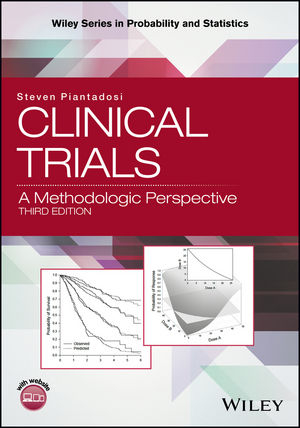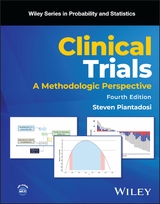
Clinical Trials
John Wiley & Sons Inc (Verlag)
978-1-118-95920-6 (ISBN)
- Titel erscheint in neuer Auflage
- Artikel merken
Presents elements of clinical trial methods that are essential in planning, designing, conducting, analyzing, and interpreting clinical trials with the goal of improving the evidence derived from these important studies
This Third Edition builds on the text’s reputation as a straightforward, detailed, and authoritative presentation of quantitative methods for clinical trials. Readers will encounter the principles of design for various types of clinical trials, and are then skillfully guided through the complete process of planning the experiment, assembling a study cohort, assessing data, and reporting results. Throughout the process, the author alerts readers to problems that may arise during the course of the trial and provides common sense solutions. All stages of therapeutic development are discussed in detail, and the methods are not restricted to a single clinical application area.
The authors bases current revisions and updates on his own experience, classroom instruction, and feedback from teachers and medical and statistical professionals involved in clinical trials. The Third Edition greatly expands its coverage, ranging from statistical principles to new and provocative topics, including alternative medicine and ethics, middle development, comparative studies, and adaptive designs. At the same time, it offers more pragmatic advice for issues such as selecting outcomes, sample size, analysis, reporting, and handling allegations of misconduct. Readers familiar with the First and Second Editions will discover revamped exercise sets; an updated and extensive reference section; new material on endpoints and the developmental pipeline, among others; and revisions of numerous sections.
In addition, this book:
• Features accessible and broad coverage of statistical design methods—the crucial building blocks of clinical trials and medical research -- now complete with new chapters on overall development, middle development, comparative studies, and adaptive designs
• Teaches readers to design clinical trials that produce valid qualitative results backed by rigorous statistical methods
• Contains an introduction and summary in each chapter to reinforce key points
• Includes discussion questions to stimulate critical thinking and help readers understand how they can apply their newfound knowledge
• Provides extensive references to direct readers to the most recent literature, and there are numerous new or revised exercises throughout the book
Clinical Trials: A Methodologic Perspective, Third Edition is a textbook accessible to advanced undergraduate students in the quantitative sciences, graduate students in public health and the life sciences, physicians training in clinical research methods, and biostatisticians and epidemiologists.
This book is accompanied by downloadable files available below under the DOWNLOADS tab.
These files include:
MATHEMATICA program – A set of downloadable files that tracks the chapters, containing code pertaining to each.
SAS PROGRAMS and DATA FILES used in the book.
The following software programs, included in the downloadables, were developed by the author, Steven Piantadosi, M.D., Ph.D:
RANDOMIZATION – This program generates treatment assignments for a clinical trial using blocked stratified randomization.
CRM – Implements the continual reassessment methods for dose finding clinical trials.
OPTIMAL – Calculates two-stage optimal phase II designs using the Simon method.
POWER – This is a power and sample size program for clinical trials.
Executables for installing these programs can also be found at https://risccweb.csmc.edu/biostats/.
Steven Piantadosi, MD, PhD, is the Phase One Foundation Distinguished Chair and Director of the Samuel Oschin Cancer Institute, and Professor of Medicine at Cedars-Sinai Medical Center in Los Angeles, California. Dr. Piantadosi is one of the world’s leading experts in the design and analysis of clinical trials for cancer research. He has taught clinical trials methods extensively in formal courses and short venues. He has advised numerous academic programs and collaborations nationally regarding clinical trial design and conduct, and has served on external advisory boards for the National Institutes of Health and other prominent cancer programs and centers. The author of more than 260 peer-reviewed scientific articles, Dr. Piantadosi has published extensively on research results, clinical applications, and trial methodology. While his papers have contributed to many areas of oncology, he has also collaborated on diverse studies outside oncology including lung disease and degenerative neurological disease.
Steven Piantadosi, MD, PhD, is the Phase One Foundation Distinguished Chair and Director of the Samuel Oschin Cancer Institute, and Professor of Medicine at Cedars-Sinai Medical Center in Los Angeles, California. Dr. Piantadosi is one of the world's leading experts in the design and analysis of clinical trials for cancer research. He has taught clinical trial methods extensively in formal courses and short venues. He has advised numerous academic programs and collaborations nationally regarding clinical trial design and conduct, and has served on external advisory boards for the National Institutes of Health and other prominent cancer programs and centers. The author of more than 260 peer-reviewed scientific articles, Dr. Piantadosi has published extensively on research results, clinical applications, and trial methodology. While his papers have contributed to many areas of oncology, he has also collaborated on diverse studies outside oncology including lung disease and degenerative neurological disease.
Preface to the Third Edition xxv
About the Companion Website xxviii
1 Preliminaries 1
1.1 Introduction 1
1.2 Audiences 2
1.3 Scope 3
1.4 Other Sources of Knowledge 5
1.5 Notation and Terminology 6
1.6 Examples, Data, and Programs 9
1.7 Summary 9
2 Clinical Trials as Research 10
2.1 Introduction 10
2.2 Research 13
2.3 Defining Clinical Trials 19
2.4 Practicalities of Usage 29
2.5 Nonexperimental Designs 35
2.6 Summary 41
2.7 Questions for Discussion 41
3 Why Clinical Trials are Ethical 43
3.1 Introduction 43
3.2 Duality 47
3.3 Historically Derived Principles of Ethics 57
3.4 Contemporary Foundational Principles 65
3.5 Methodologic Reflections 72
3.6 Professional Conduct 79
3.7 Summary 85
3.8 Questions for Discussion 86
4 Contexts for Clinical Trials 87
4.1 Introduction 87
4.2 Drugs 91
4.3 Devices 95
4.4 Prevention 99
4.5 Complementary and Alternative Medicine 106
4.6 Surgery and Skill-Dependent Therapies 116
4.7 A Brief View of Some Other Contexts 130
4.8 Summary 135
4.9 Questions for Discussion 136
5 Measurement 137
5.1 Introduction 137
5.2 Objectives 140
5.3 Measurement Design 143
5.4 Surrogate Outcomes 162
5.5 Summary 170
5.6 Questions for Discussion 171
6 Random Error and Bias 172
6.1 Introduction 172
6.2 Clinical Bias 181
6.3 Statistical Bias 188
6.4 Summary 194
6.5 Questions for Discussion 194
7 Statistical Perspectives 196
7.1 Introduction 196
7.2 Differences in Statistical Perspectives 197
7.3 Frequentist 202
7.4 Bayesian 204
7.5 Likelihood 210
7.6 Statistics Issues 212
7.7 Summary 215
7.8 Questions for Discussion 216
8 Experiment Design in Clinical Trials 217
8.1 Introduction 217
8.2 Trials As Simple Experiment Designs 218
8.3 Goals of Experiment Design 223
8.4 Design Concepts 225
8.5 Design Features 230
8.6 Special Design Issues 237
8.7 Importance of the Protocol Document 244
8.8 Summary 252
8.9 Questions for Discussion 253
9 The Trial Cohort 254
9.1 Introduction 254
9.2 Cohort Definition and Selection 255
9.3 Modeling Accrual 264
9.4 Inclusiveness, Representation, and Interactions 267
9.5 Summary 275
9.6 Questions for Discussion 275
10 Development Paradigms 277
10.1 Introduction 277
10.2 Pipeline Principles and Problems 281
10.3 A Simple Quantitative Pipeline 286
10.4 Late Failures 292
10.5 Summary 300
10.6 Questions for Discussion 301
11 Translational Clinical Trials 302
11.1 Introduction 302
11.2 Inferential Paradigms 308
11.3 Evidence and Theory 312
11.4 Translational Trials Defined 313
11.5 Information From Translational Trials 317
11.5.6 Sample Size for Translational Trials 324
11.5.7 Validity 327
11.6 Summary 328
11.7 Questions for Discussion 328
12 Early Development and Dose-Finding 329
12.1 Introduction 329
12.2 Basic Concepts 330
12.3 Essential Concepts for Dose versus Risk 333
12.4 Dose-Ranging 338
12.5 Dose-Finding is Model Based 344
12.6 General Dose-Finding Issues 354
12.7 Summary 366
12.8 Questions for Discussion 368
13 Middle Development 370
13.1 Introduction 370
13.2 Characteristics of Middle Development 372
13.3 Design Issues 375
13.4 Middle Development Distills True Positives 379
13.5 Futility and Nonsuperiority Designs 381
13.6 Dose–Efficacy Questions 385
13.7 Randomized Comparisons 386
13.8 Cohort Mixtures 392
13.9 Summary 395
13.10 Questions for Discussion 396
14 Comparative Trials 397
14.1 Introduction 397
14.2 Elements of Reliability 398
14.3 Biomarker-Based Comparative Designs 402
14.4 Some Special Comparative Designs 408
14.5 Summary 411
14.6 Questions for Discussion 412
15 Adaptive Design Features 413
15.1 Introduction 413
15.2 Some Familiar Adaptations 418
15.3 Biomarker Adaptive Trials 423
15.4 Re-Designs 425
15.5 Seamless Designs 427
15.6 Barriers to the Use of AD 428
15.7 Adaptive Design Case Study 428
15.8 Summary 429
15.9 Questions for Discussion 429
16 Sample Size and Power 430
16.1 Introduction 430
16.2 Principles 431
16.3 Early Developmental Trials 436
16.4 Simple Estimation Designs 438
16.5 Event Rates 451
16.6 Staged Studies 455
16.7 Comparative Trials 457
16.8 Expanded Safety Trials 478
16.9 Other Considerations 481
16.10 Summary 489
16.11 Questions for Discussion 490
17 Treatment Allocation 492
17.1 Introduction 492
17.2 Randomization 494
17.3 Constrained Randomization 500
17.4 Adaptive Allocation 504
17.5 Other Issues Regarding Randomization 507
17.6 Unequal Treatment Allocation 514
17.7 Randomization Before Consent 519
17.8 Summary 520
17.9 Questions for Discussion 520
18 Treatment Effects Monitoring 522
18.1 Introduction 522
18.2 Administrative Issues in Trial Monitoring 527
18.3 Organizational Issues Related to Monitoring 537
18.4 Statistical Methods for Monitoring 545
18.5 Summary 570
18.6 Questions for Discussion 572
19 Counting Subjects and Events 573
19.1 Introduction 573
19.2 Imperfection and Validity 574
19.3 Treatment Nonadherence 575
19.4 Protocol Nonadherence 580
19.5 Data Imperfections 583
19.6 Summary 588
19.7 Questions for Discussion 589
20 Estimating Clinical Effects 590
20.1 Introduction 590
20.2 Dose-Finding and Pharmacokinetic Trials 594
20.3 Middle Development Studies 599
20.4 Randomized Comparative Trials 606
20.5 Problems With P-Values 616
20.6 Strength of Evidence Through Support Intervals 620
20.7 Special Methods of Analysis 622
20.8 Exploratory Analyses 628
20.9 Summary 639
20.10 Questions for Discussion 640
21 Prognostic Factor Analyses 644
21.1 Introduction 644
21.2 Model-Based Methods 647
21.3 Adjusted Analyses of Comparative Trials 661
21.4 PFAS Without Models 666
21.5 Summary 669
21.6 Questions for Discussion 669
22 Factorial Designs 671
22.1 Introduction 671
22.2 Characteristics of Factorial Designs 672
22.3 Treatment Interactions 675
22.4 Examples of Factorial Designs 680
22.5 Partial Fractional and Incomplete Factorials 682
22.6 Summary 683
22.7 Questions for Discussion 683
23 Crossover Designs 684
23.1 Introduction 684
23.2 Advantages and Disadvantages 686
23.3 Analysis 691
23.4 Classic Case Study 696
23.5 Summary 696
23.6 Questions for Discussion 697
24 Meta-Analyses 698
24.1 Introduction 698
24.2 A Sketch of Meta-Analysis Methods 700
24.3 Other Issues 705
24.4 Summary 707
24.5 Questions for Discussion 708
25 Reporting and Authorship 709
25.1 Introduction 709
25.2 General Issues in Reporting 710
25.3 Clinical Trial Reports 715
25.4 Authorship 726
25.5 Other Issues in Disseminating Results 731
25.6 Summary 732
25.7 Questions for Discussion 733
26 Misconduct and Fraud in Clinical Research 734
26.1 Introduction 734
26.2 Research Practices 741
26.3 Approach to Allegations of Misconduct 743
26.4 Characteristics of Some Misconduct Cases 747
26.5 Lessons 754
26.6 Clinical Investigators’ Responsibilities 757
26.7 Summary 759
26.8 Questions for Discussion 760
Appendix A Data and Programs 761
A.1 Introduction 761
A.2 Design Programs 761
A.3 Mathematica Code 763
Appendix B Abbreviations 764
Appendix C Notation and Terminology 769
C.1 Introduction 769
C.2 Notation 769
C.3 Terminology and Concepts 772
Appendix D Nuremberg Code 788
D.1 Permissible Medical Experiments 788
References 790
Index 871
| Erscheinungsdatum | 29.10.2017 |
|---|---|
| Reihe/Serie | Wiley Series in Probability and Statistics |
| Verlagsort | New York |
| Sprache | englisch |
| Maße | 178 x 259 mm |
| Gewicht | 1814 g |
| Themenwelt | Mathematik / Informatik ► Mathematik ► Wahrscheinlichkeit / Kombinatorik |
| Medizin / Pharmazie ► Medizinische Fachgebiete | |
| Studium ► Querschnittsbereiche ► Epidemiologie / Med. Biometrie | |
| ISBN-10 | 1-118-95920-5 / 1118959205 |
| ISBN-13 | 978-1-118-95920-6 / 9781118959206 |
| Zustand | Neuware |
| Informationen gemäß Produktsicherheitsverordnung (GPSR) | |
| Haben Sie eine Frage zum Produkt? |
aus dem Bereich



